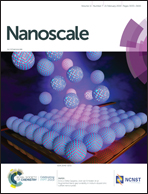High photoresponsivity and broadband photodetection with a band-engineered WSe2/SnSe2 heterostructure†
Abstract
van der Waals (vdW) heterostructures formed by stacking different two-dimensional layered materials have been demonstrated as a promising platform for next-generation photonic and optoelectronic devices due to their tailorable band-engineering properties. Here, we report a high photoresponsivity and broadband photodetector based on a WSe2/SnSe2 heterostructure. By properly biasing the heterostructure, its band structure changes from near-broken band alignment to type-III band alignment which enables high photoresponsivity from visible to telecommunication wavelengths. The highest photoresponsivity and detectivity at 532 nm are ∼588 A W−1 and 4.4 × 1010 Jones and those at 1550 nm are ∼80 A W−1 and 1.4 × 1010 Jones, which are superior to those of the current state-of-the-art layered transition metal dichalcogenides based photodetectors under similar measurement conditions. Our work not only provides a new method for designing high-performance broadband photodetectors but also enables a deep understanding of the band engineering technology in the vdW heterostructures possible for other applications, such as modulators and lasers.



 Please wait while we load your content...
Please wait while we load your content...